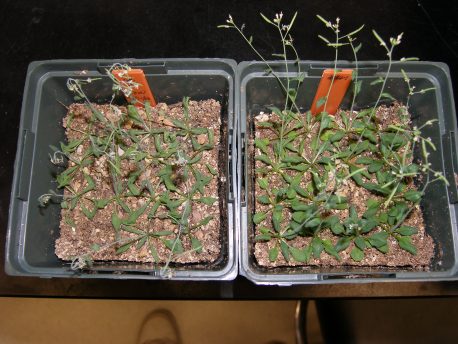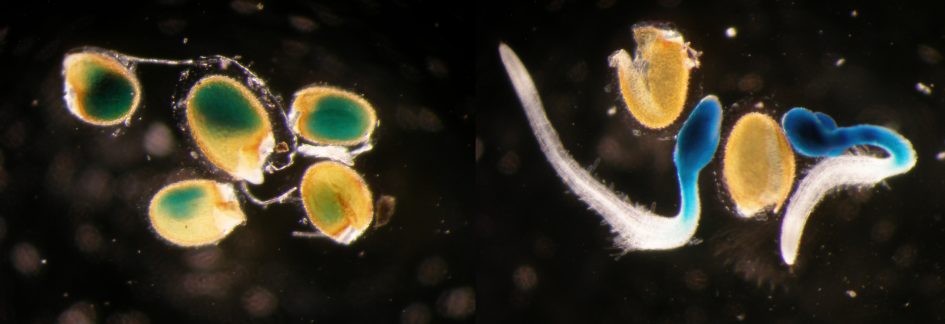
August 11, 2016
Salk researchers discover that a plant molecule once regarded as a biological dead end now offers new leads into the development of hardier plants
Salk researchers discover that a plant molecule once regarded as a biological dead end now offers new leads into the development of hardier plants
LA JOLLA—The best natural chemists out there are not scientists—they’re plants. Plants have continued to evolve a rich palette of small natural chemicals and receptors since they began to inhabit land roughly 450 million years ago.
Now, research by Salk Institute scientists published August 11, 2016 in the journal Cell reveals an unexpected role for a small, often overlooked molecule called phaseic acid, which has historically been cast as an inactive byproduct in plants—a metabolic dead end of sorts. The new findings suggest that phaseic acid and its receptors probably co-evolved to become crucial for drought resistance and other survival traits and may inform the development of new, hardier crops that can weather natural disasters wrought by climate change.

Click here for a high-resolution image.
Credit: Salk Institute
“There had been some hints that phaseic acid was not just an inactive bystander but a plant hormone with an important role,” says the study’s senior investigator Joseph Noel, holder of the Arthur and Julie Woodrow Chair and professor in the Jack H. Skirball Center for Chemical Biology and Proteomics at Salk. “But now, by using an array of cutting-edge biological approaches, we’ve shown more convincingly, that phaseic acid is likely important for survival.”
Phaseic acid has long lived in the shadows of its precursor—abscisic acid or ABA—which is a big deal in plant research. ABA is a plant hormone that’s present in all land plants and is key for responding to environmental stress and pathogens, in particular alerting the plant to drought conditions. ABA is also known for its connection to the good stuff in fruits and vegetables: carotenoids, such as beta-carotene and lycopene.
Like all small natural molecules, ABA is produced through intricate metabolic pathways that transform simple carbon-based building blocks into structurally complex natural chemicals that collectively convey a substantial amount of information. Some plants are equipped with more than a handful of receptors for ABA, each of which carries out various functions in the plant. But paradoxically for its role as a master regulator, ABA itself seemed have equal preference for all its receptors, which would not be ideal for the fine-tuned control of plant function.
In the new study, Noel’s team used a commonly studied plant called Arabidopsis thaliana and obtained varieties that lacked the enzyme that processes phaseic acid, in effect accumulating large amounts of phaseic acid.
To the group’s surprise, the plants showed changes to the timing of seed germination and they survived without water for a longer time period. “This suggested to us that maybe we should be thinking of phaseic acid not as an inactive degradation product but actually as a molecule that had its own capacity to cause changes like other plant hormones,” says Noel.

Click here for a high-resolution image.
Credit: Salk Institute
The scientists carried out a series of studies pointing to phaseic acid’s role as a plant hormone, showing for example that the addition of phaseic acid to normal seedlings triggered changes to the expression of numerous specific genes, especially genes coding for metabolic enzymes, that were overlapping but also distinct from those activated by ABA.
In addition, using a high-resolution imaging technique called x-ray crystallography, the group showed that phaseic acid bound to ABA’s receptors, solidifying evidence that ABA’s receptors can sense more than just ABA.
The new study suggests more broadly that there could be more hidden complexity to how organisms make use of small chemicals to bring about a variety of different responses. Evolution may well have repurposed other so-called end products of metabolism, Noel says.
The study’s first author, Jing-Ke Weng, formerly a postdoctoral researcher in Noel’s lab, has set up an independent research group within Massachusetts Institute of Technology’s Whitehead Institute for Biomedical Research and Department of Biology that will continue to explore plant chemicals with previously unappreciated roles. “We hope to discover and understand the complexity of the hormones’, their metabolites and their collective interplay with receptors in various plants,” says Weng.
Noel’s team will study the role of the hormones in the roots of plants. There is evidence that the phaseic acid and ABA play a role in moving carbon from a plant’s leaves and stems into its roots to protect them during periods of drought, overwintering and during pathogen attacks in the soil, Noel says. “Understanding this area of plant biology offers new ways to think about how we might mitigate climate change.”
This research was supported by the National Science Foundation, the Pioneer Foundation, the Pew Charitable Trusts, the Searle Scholars Program and the Howard Hughes Medical Institute.
Other authors on the study are Mingli Ye of the Salk Institute and Bin Li of the University of California, San Diego School of Medicine.
JOURNAL
Cell
AUTHORS
Jing-Ke Weng, Mingli Ye, Bin Li, Joseph P. Noel
Office of Communications
Tel: (858) 453-4100
press@salk.edu
Unlocking the secrets of life itself is the driving force behind the Salk Institute. Our team of world-class, award-winning scientists pushes the boundaries of knowledge in areas such as neuroscience, cancer research, aging, immunobiology, plant biology, computational biology and more. Founded by Jonas Salk, developer of the first safe and effective polio vaccine, the Institute is an independent, nonprofit research organization and architectural landmark: small by choice, intimate by nature, and fearless in the face of any challenge.